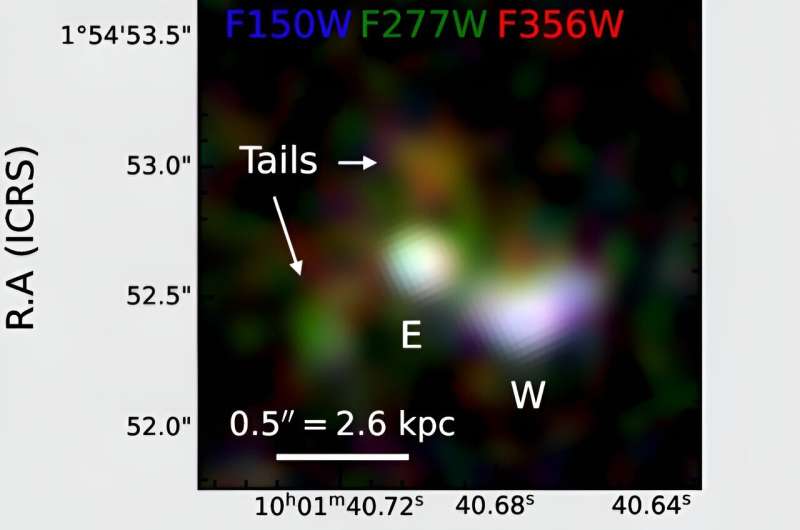April 4, 2024 report
This article has been reviewed according to Science X's editorial process and policies. Editors have highlighted the following attributes while ensuring the content's credibility:
fact-checked
preprint
trusted source
proofread
Observations reveal complex morphology of Big Three Dragons

Using the James Webb Space Telescope (JWST) and the Atacama Large Millimeter/sub-millimeter Array (ALMA), an international team of astronomers has observed a merging galaxy system known as B14-65666, dubbed "Big Three Dragons." As a result, they found that the system has a complex morphology and experiences dusty starbursts. The finding was detailed in a paper published March 25 on the pre-print server arXiv.
Galaxy mergers play an essential role in the evolution of galaxies. Major mergers even have the ability to change the shape of the parent galaxies and form an object with a completely new morphology.
B14-65666 is a system merged from two galaxies, located 13 billion light years away in the constellation Sextans. Therefore, it is the earliest observed galaxy merger as it took place less than 1 billion years after the Big Bang. The total mass of the system is estimated to be 770 million solar masses and its total star formation rate is about 200 solar masses per year, indicating that it is a starburst galaxy.
Recently, a group of astronomers led by Yuma Sugahara of the National Astronomical Observatory of Japan (NAOJ) decided to take a closer look at this merger. They used JWST's Near Infrared Camera (NIRCam) and archival ALMA imagery to investigate the Big Three Dragons.
"The high angular resolution of these NIRCam and ALMA observations enables spatially resolved analyses at the rest-frame ultraviolet, optical, and far-infrared wavelengths of B14 65666, a bright major merger in the EoR [epoch of reionization]," the researchers explained.
The observations found that B14-65666 consists of two galaxy components, designated "E" and "W," and diffuse emission surrounding the galaxy E. NIRCam images revealed that both components showcase a complex morphology.
According to the study, galaxy E is red and has a compact core with an effective radius of less than 277 light years. The core appears to be surrounded by diffuse, extended, rest-frame optical emission, which is likely to be tidal tails created by gravitational interactions.
The galaxy W is blue and elongated to 4,900 light years, with clumpy morphology in the rest-frame ultraviolet wavelengths. The images show that the galaxy W is brighter in dust continua than the redder galaxy E.
The study found that the averaged star-formation rate in the last 10 million years is at a level of approximately 180 solar masses per year for the galaxy E. This is about four times higher than in the galaxy W. The characteristic dust temperatures were measured to be 50 and 40 K for the galaxies E and W, respectively.
The obtained results suggest that galaxy E is in a dusty starburst phase. The astronomers suppose that E is composed of the dusty compact starbursts at the nucleus and the older stars in the tails which dominate the stellar mass.
All in all, the authors of the paper conclude that B14-65666 is a major merger that gravitationally disturbs the morphology and experiences nuclear dusty starbursts likely triggered by less-enriched gas inflows.
More information: Yuma Sugahara et al, RIOJA. Complex Dusty Starbursts in a Major Merger B14-65666 at z=7.15, arXiv (2024). DOI: 10.48550/arxiv.2403.17133
Journal information: arXiv
© 2024 Science X Network



















